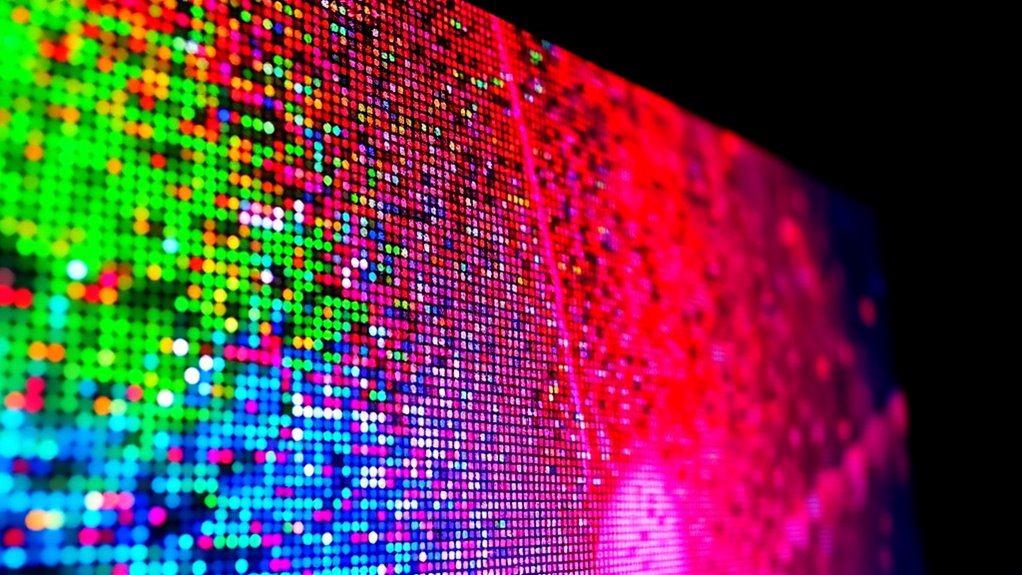Quantum dots in TVs boost brightness and color vividness by converting the backlight into precise, pure colors. They emit narrow spectral wavelengths, allowing for more saturated reds, greens, and blues, which results in a wider color gamut and brighter images. Their high efficiency means you get vibrant visuals with less power consumption. If you want to learn how these tiny particles achieve such stunning effects, stay tuned for a detailed explanation.
Key Takeaways
- Quantum dots produce narrow, pure emission wavelengths, resulting in more vibrant and saturated colors on TVs.
- Their size control allows precise tuning of red and green emissions, enhancing overall brightness and color purity.
- Quantum dots convert blue LED backlights into specific red and green light, increasing luminous efficiency and brightness.
- They enable wider color gamuts, allowing TVs to display more vivid images with higher color accuracy.
- Quantum dot technology delivers higher peak brightness and stability, improving HDR performance and overall visual impact.
What Are Quantum Dots and How Do They Work in TVs
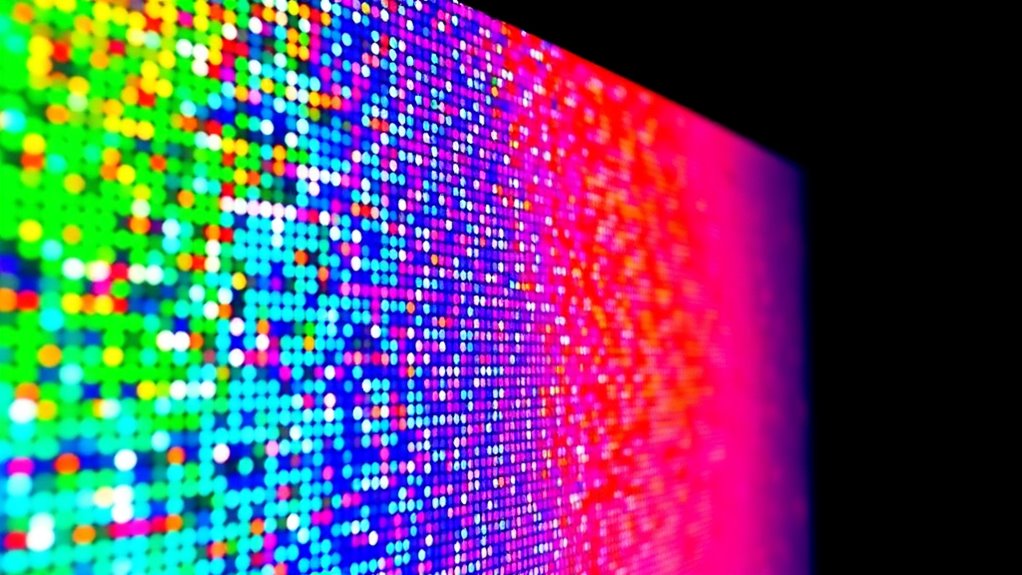
Quantum dots are tiny semiconductor particles, measuring just 2 to 10 nanometers across, whose size directly influences the color of light they emit. When you shine a blue LED light on them, they fluoresce, emitting red or green light depending on their size—larger dots produce red, smaller dots produce green. This ability to absorb a range of wavelengths and emit at specific, precise wavelengths allows for highly accurate color reproduction. Manufacturers embed quantum dots in a film within the display, where they convert backlight into pure colors. By adjusting the size, shape, or material of these dots, you can fine-tune the emitted color. This process improves color accuracy and brightness, making your TV’s images more vibrant and true to life. Additionally, advancements in energy efficiency help reduce power consumption while enhancing display performance, and their long lifespan ensures consistent color quality over time. Moreover, the manufacturing process of quantum dots has become more refined, leading to better uniformity and performance across displays. As research continues, new quantum dot materials are being developed to further improve display quality and environmental sustainability. Furthermore, ongoing innovations aim to optimize cost-effectiveness, making quantum dot technology more accessible to a wider range of consumers.
Enhancing Color Gamut and Visual Vibrancy
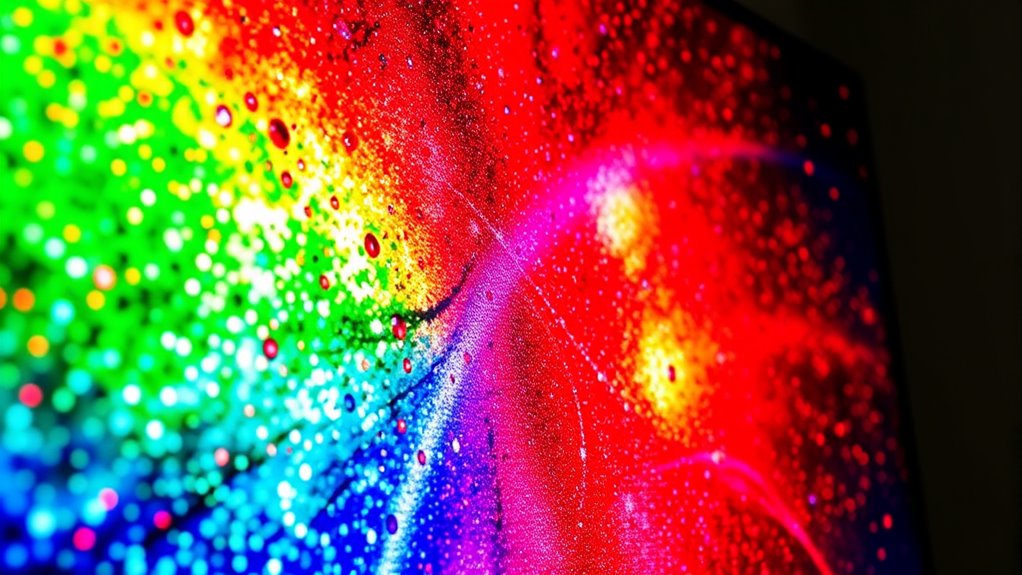
Thanks to their narrow spectral emissions, quantum dots produce purer and more saturated colors than traditional display technologies. Their precise wavelength control allows you to enjoy a markedly wider color gamut, often exceeding 90% of industry standards like DCI-P3 or Rec. 2020. This means more vivid reds, greens, and blues, reducing color clipping and banding in intense scenes. Because quantum dots emit at wavelengths that match human visual sensitivities, your display can showcase more vibrant, distinct hues. The improved color separation minimizes overlap among color channels, resulting in sharper, more lifelike images. Additionally, fraud detection techniques such as machine learning algorithms help monitor and enhance the security of digital content and transactions. These advancements drive innovation in display technology, delivering even more impressive visual experiences. Moreover, the use of quantum dots can contribute to energy efficiency by enabling brighter displays without increasing power consumption. Overall, quantum dots enhance your viewing experience by delivering richer colors, greater color fidelity, and a more immersive, eye-catching picture.
The Role of Quantum Dots in Brightness Improvement
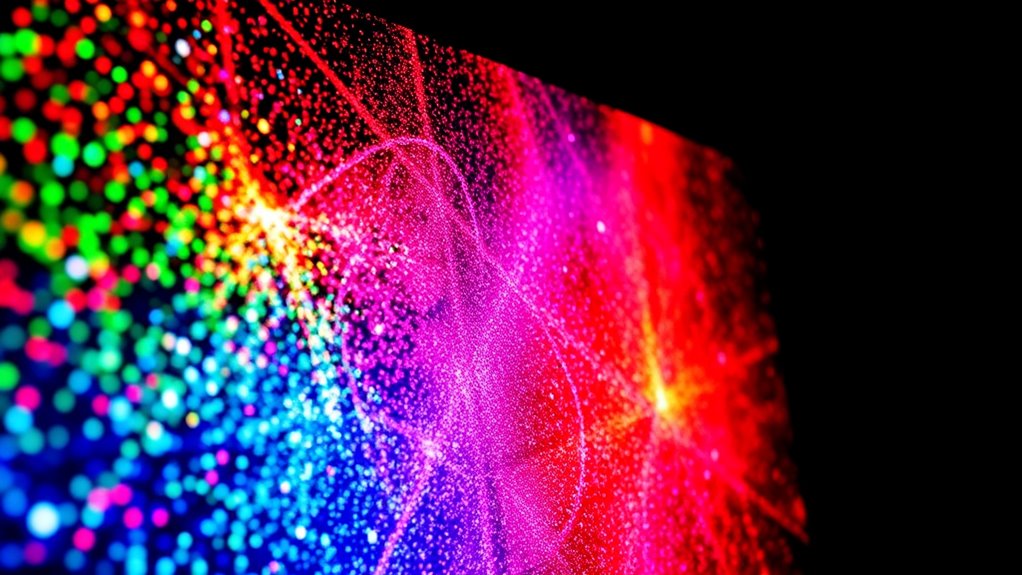
Building on their ability to produce richer colors, quantum dots also play a key role in boosting display brightness. Their high luminescence efficiency means they convert light with minimal loss, allowing for brighter images without extra power. By reducing light loss common in traditional color filters, quantum dots produce more intense, pure light thanks to narrow spectral emission. They absorb blue light from LED backlights and re-emit it as precise red and green, minimizing energy waste as heat or scattered light. Advances in quantum dot materials now enable higher photon emission rates and stable brightness over time, even at peak levels exceeding 3600 nits. This improved efficiency results in brighter displays that perform well in bright environments, all while consuming less power and maintaining longevity. Additionally, the spectral emission of quantum dots can be finely tuned during manufacturing to optimize light output and color accuracy. Their energy conversion efficiency further enhances overall display performance and contributes to longer-lasting screens, especially as innovations continue to improve display technology and user experience. Furthermore, material stability plays a crucial role in maintaining consistent brightness throughout the lifespan of quantum dot-enhanced displays.
Comparing Quantum Dot Displays to Traditional LCDs
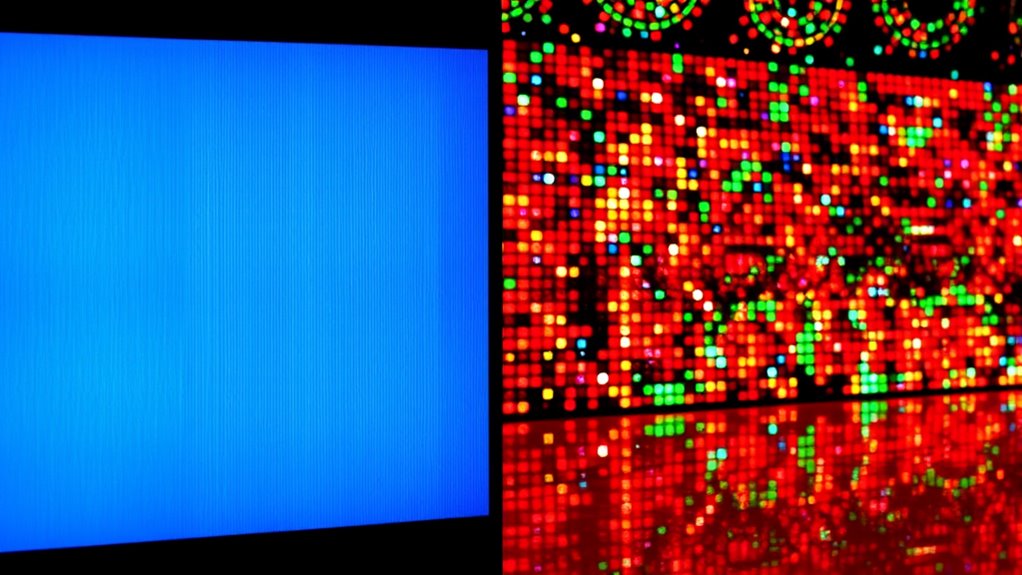
While both quantum dot displays and traditional LCDs rely on liquid crystal technology and backlighting, quantum dot displays enhance performance by adding a specialized layer that improves color and brightness. Unlike traditional LCDs, which depend solely on white LED backlights and color filters, quantum dot layers emit more precise wavelengths, resulting in a wider color gamut and more accurate colors. This means your TV can display more vibrant and saturated images with better color volume, even at high brightness levels. Quantum dot displays also produce higher peak brightness, making HDR content pop and improving visibility in bright rooms. Additionally, the use of quantum dots allows for better brightness levels, providing an overall more vivid picture. Furthermore, quantum dot technology can be integrated with advanced energy efficiency features, reducing power consumption while delivering superior image quality. As a result, viewers can enjoy a more immersive viewing experience with richer details. Although both types are LCD-based, the addition of quantum dots remarkably boosts color accuracy, brightness, and overall picture quality, providing a more immersive viewing experience.
Integration of Quantum Dots Into Existing Manufacturing Processes
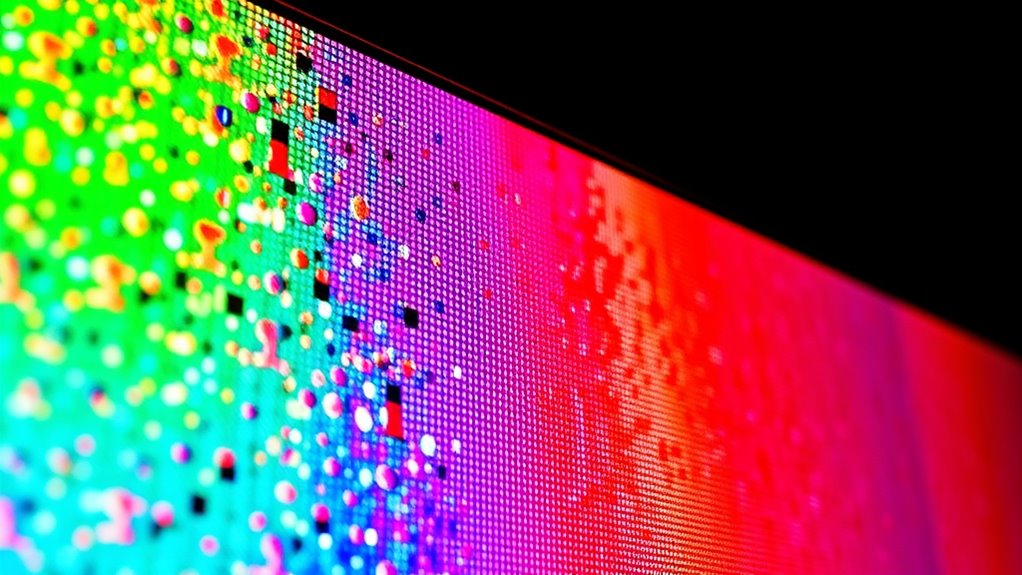
Integrating quantum dots into existing LCD manufacturing processes is designed to be straightforward, allowing manufacturers to boost display performance without overhauling their current systems. The most common method is film-based integration, where Quantum Dot Enhancement Films (QDEF) are inserted between existing barrier films, making it a drop-in solution. This approach simplifies manufacturing by leveraging existing infrastructure and requires minimal reconfiguration, reducing costs and time. QDEF films replace traditional diffuser layers in backlights, improving color accuracy and efficiency with little process disruption. Edge-type integration, although possible, faces scalability and heat management challenges. Overall, using quantum dots adds value with minimal changes, giving manufacturers a cost-effective way to enhance display quality while maintaining compatibility with existing production lines. Incorporating quantum dot technology into manufacturing processes also helps in achieving brighter colors and better energy efficiency. Additionally, this method supports sustainable manufacturing practices by reducing material waste and energy consumption during production.
How Quantum Dots Achieve Precise Color Emission
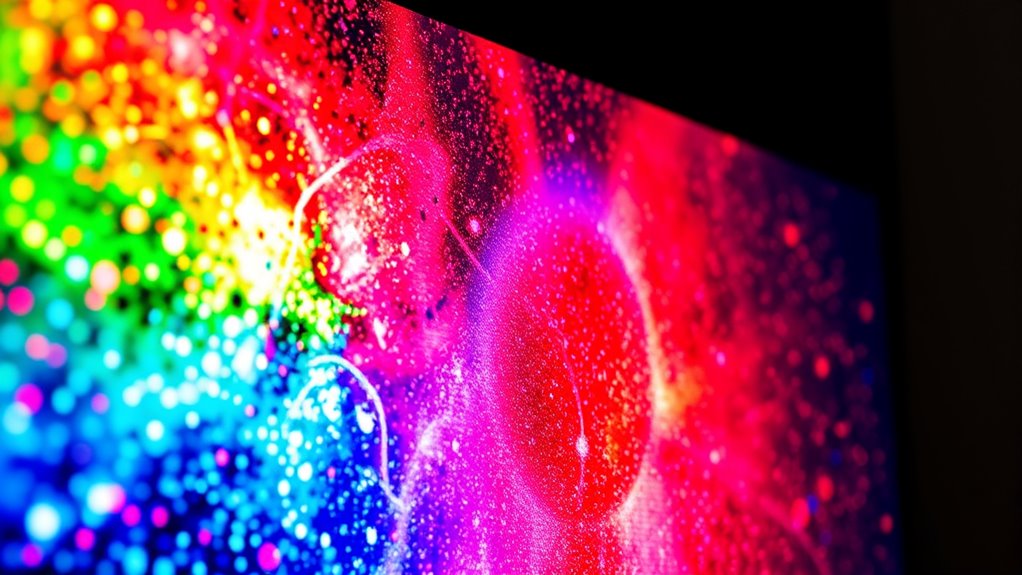
Quantum dots achieve precise color emission primarily through their size-dependent optical properties. When you change the size of a quantum dot, you alter its energy levels via the quantum confinement effect, which directly influences the bandgap. Smaller dots have larger bandgaps, emitting bluer light, while larger dots have smaller bandgaps, producing redder hues. This size control allows you to tune the emission wavelength with remarkable accuracy. The material composition also plays a role, with different materials like CdSe or In-based quantum dots emitting specific colors. When electrons and holes recombine within these dots, they release photons at specific wavelengths, creating pure, vivid colors. Because of their narrow emission spectrum and controllable properties, quantum dots deliver highly precise and vibrant colors in modern displays. Understanding quantum confinement helps explain how size variations lead to different emission wavelengths. Additionally, advances in manufacturing techniques ensure consistent quantum dot quality, enhancing display quality.
Benefits of Quantum Dot Technology for Consumers
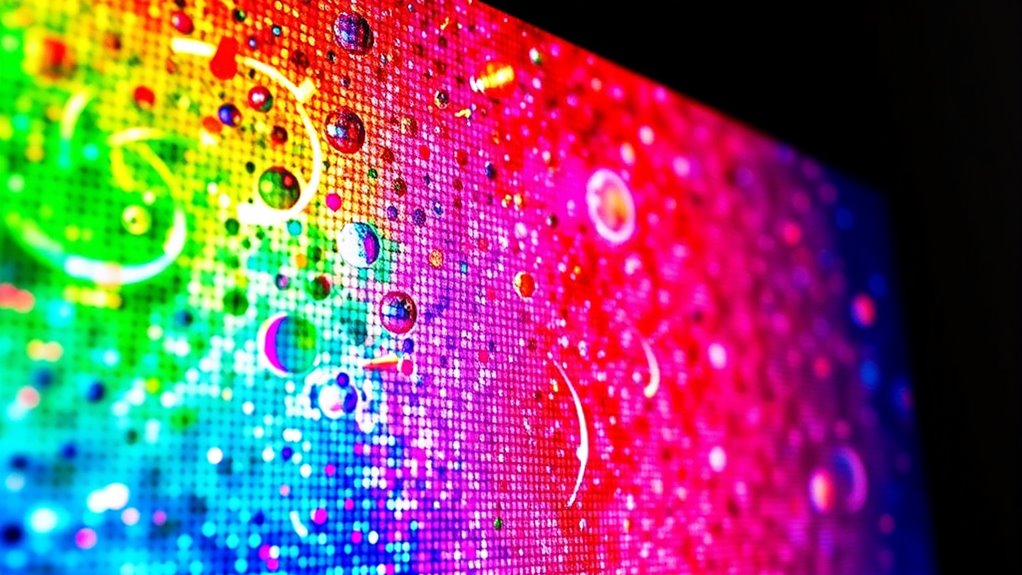
Have you noticed how quantum dot technology enhances TV visuals? It delivers more accurate colors by producing specific wavelengths, making images vibrant and true to life. You’ll also enjoy higher brightness levels without losing color quality, even in well-lit rooms. This technology is more energy-efficient, meaning your TV uses less power while still providing stunning visuals. Quantum dots expand the color spectrum, so you’ll see richer, more nuanced images across a wider range of colors. Additionally, they enable better color stability, maintaining image quality over time. This is especially important considering the long-term performance of display technology. The use of quantum dots also improves the spectral efficiency of TVs, allowing manufacturers to deliver better performance without significantly increasing costs. Plus, they help keep costs down, as they’re compatible with existing LCD manufacturing processes, making these TVs more affordable than OLEDs. Overall, quantum dot tech offers a brighter, more colorful, and energy-friendly viewing experience, ensuring you get the most vivid images for your entertainment.
Future Trends and Developments in Quantum Dot TV Displays
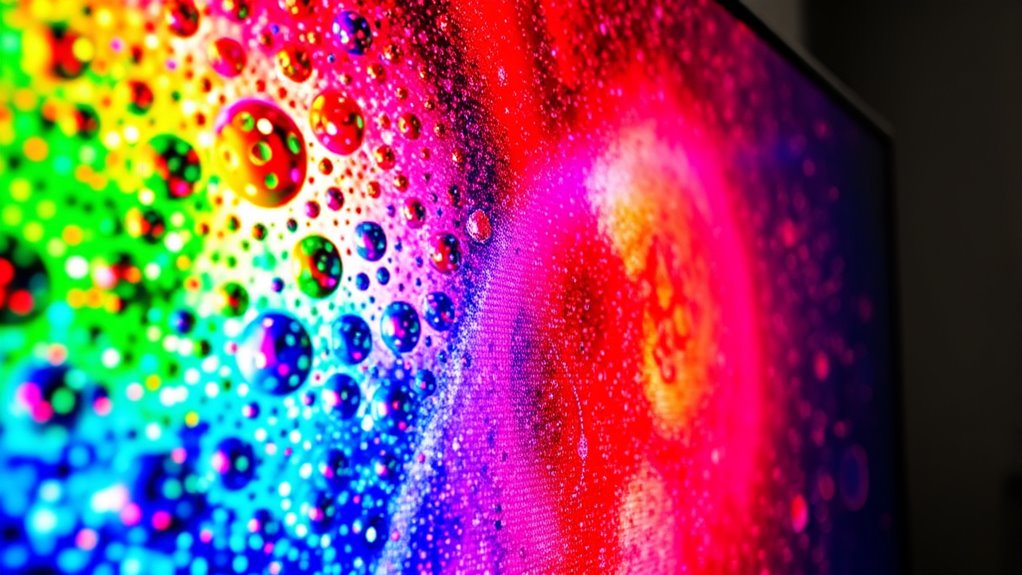
Advances in quantum dot technology are paving the way for revolutionary improvements in TV displays. You’ll see self-emissive QD-OLED hybrids that combine color purity with OLED’s self-emission, removing the need for backlighting. NanoLED prototypes, like Sharp’s 12.3-inch model, promise ultra-thin, high-brightness screens. Researchers are developing cadmium-free materials, such as indium phosphide, to meet environmental standards. Flexible and wearable quantum dots will enable bendable displays for AR, VR, and foldables. Technological progress includes brighter nanoLEDs surpassing OLED brightness, wider color gamuts reaching Rec.2020, and more energy-efficient photon conversion. Future displays will feature deeper blacks with mini-LED backlights, higher HDR brightness, and lower power consumption. Quantum dot technology continues to evolve, driving innovation in display performance, color accuracy, and environmental sustainability. The ongoing development of manufacturing techniques like UPD printing will make these advanced displays more accessible and sustainable. Market growth and manufacturing innovations, like UPD printing, will make these advanced displays more accessible and sustainable.
Frequently Asked Questions
Are Quantum Dot TVS More Energy-Efficient Than OLEDS?
You might wonder if Quantum Dot TVs are more energy-efficient than OLEDs. While Quantum Dots improve color performance, they don’t markedly boost energy efficiency. OLED TVs typically use less power because they control each pixel individually, turning off pixels completely for black scenes. Quantum Dot TVs often rely on backlighting, which consumes more energy. So, if energy savings matter most, OLEDs generally remain the more efficient choice.
How Long Do Quantum Dots Maintain Their Color Accuracy?
You might wonder how long quantum dots keep their color accuracy. Typically, they last around 100,000 hours, which equals over 11 years of continuous use without significant fading. The durable metal coatings and protective layers shield them from environmental damage, ensuring bright, accurate colors over time. With proper care, your quantum dot TV will maintain its vivid picture quality well beyond a decade, providing consistent performance and color stability.
Can Quantum Dots Be Used in Flexible or Curved Displays?
You’re asking if quantum dots can be used in flexible or curved displays, and the answer is yes—these tiny wonders are making waves in the industry. They can be integrated into flexible backlight modules and ultrathin, foldable QLEDs, maintaining performance under bending and shaping. This means you can enjoy vibrant, high-quality displays that adapt to your needs, proving that the sky’s the limit when it comes to flexible quantum dot technology.
Do Quantum Dot TVS Emit Any Harmful Radiation?
You might wonder if quantum dot TVs emit harmful radiation. Rest assured, they don’t. These TVs use quantum dots that emit light through photoluminescence, excited by external light sources, not radioactive processes. The quantum dots are safely embedded behind layers of glass and plastic, minimizing exposure. They’re designed to improve brightness and color accuracy without releasing harmful radiation, making them safe for everyday use.
Is There a Significant Price Difference Between Quantum Dot and OLED TVS?
You’re wondering if quantum dot TVs cost considerably more than OLEDs. Typically, yes. QLED TVs are usually more affordable due to simpler manufacturing, offering bright, vivid colors at a lower price. OLEDs, with their complex panels and self-emitting pixels, tend to be pricier, especially in larger sizes. However, QD-OLEDs are emerging as a middle ground, combining both techs but currently at a higher cost than traditional OLEDs.
Conclusion
So, now you know quantum dots make your TV’s colors brighter and more vibrant—because who doesn’t want their screen to sparkle like a disco ball? But remember, all that glow might just distract you from the fact that deeper, richer hues are now just a click away, making you wonder if your eyes are the real winners or just the latest technology’s glamorous accomplice. Enjoy your dazzling new world—just don’t forget to blink once in a while.
